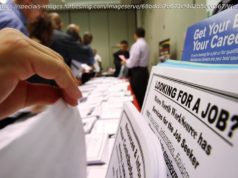The first round of the Fed’s annual stress tests found banks are prepared to withstand a downturn, which could presage big shareholder payouts next week.
The nation’s biggest banks are strong enough to continue lending if the economy plunges into a severe downturn, the Federal Reserve said on Thursday, a determination that could further fuel Wall Street’s calls to further relax financial regulations.
The results of the first phase of the Fed’s annual “stress tests” showed that the country’s banks have more than enough capital to survive the combination of a recession, cratering of housing prices and double-digit unemployment.
The banks — riding high on the spoils of the new tax-cut law and a string of recent moves to relax regulations — are eager to return more of their profits to shareholders, and the test results suggest regulators will give many the green light to pay dividends or buy their own shares next week.
Still, two Wall Street giants — Goldman Sachs and Morgan Stanley — came close to falling below one of the Fed’s minimum thresholds, the so-called supplementary leverage ratio. That metric is intended to constrain the amounts that banks borrow. Large banks are required to maintain a supplementary leverage ratio of at least 3 percent of their assets and certain other positions. Goldman Sachs’s ratio was as low as 3.1 percent, while Morgan Stanley’s lowest was 3.3 percent.
Those low ratios mean the two banks might have to reconsider how much money they want to return to shareholders in the form of dividends and share buybacks. Next week, the Fed will run a more consequential round of stress tests, in which the regulator will decide whether banks are strong and well-managed enough to afford their dividend and buyback plans.
The Fed’s annual simulation tested 35 of the largest banks, including the United States units of several foreign banks. Under the Fed’s “severely adverse scenario,” which envisions a rapid descent into a recession, banks would suffer losses totaling $578 billion, but they would retain enough capital to stay above the minimum capital levels required by the Fed.
The ability of most banks to breeze through the tests is an indication of how far Wall Street has come since the financial crisis. A decade ago, bad bets on the housing market crippled much of the industry and required government bailouts of hundreds of banks. To prevent a repeat of those taxpayer-financed rescues, the Fed now requires banks to maintain capital cushions that would allow them to keep lending during periods of financial stress.
Since 2009, the 35 banks have added about $800 billion in the highest quality type of capital, the Fed said.
“Despite a tough scenario and other factors that affected this year’s test, the capital levels of the firms after the hypothetical severe global recession are higher than the actual capital levels of large banks in the years leading up to the most recent recession,” Randal K. Quarles, the Fed’s vice chairman for supervision, said in a statement.
This is the second year that all the big United States banks were found to have enough capital to withstand a hypothetical recession. In 2017, the big banks sailed through the first round of the stress tests and, a week later, the Fed approved capital plans for all 34 banks that took part in the exercise.
Wells Fargo, which has faced a series of regulatory penalties stemming from its sales practices, was among the banks to easily clear the Fed’s hurdles. Its key capital ratio was 8.6 percent, above the Fed’s 4.5 percent minimum. That was the highest among the country’s five largest banks, as measured by assets.
Other large banks weren’t far behind, with Bank of America, Citigroup and JPMorgan Chase showing that their capital ratios would have held above 7 percent under the Fed’s worst-case economic scenario.
While the results are likely to cheer bank executives and shareholders, skeptics cautioned against regulators responding to the strong performances by watering down safeguards against future crises.
“This just shows that regulators’ models are saying that you have O. K. capital. But guess what, regulators’ models said before the financial crisis that you had O. K. capital, too,” said Marcus Stanley, policy director at Americans for Financial Reform, an advocacy group that pushes for tougher financial regulation. “I don’t think that this is telling us that everything is O. K. and we don’t need to be vigilant.”
The strong results are likely to give banks more momentum to lobby to further relax regulations. Banks have successfully pushed the Fed to relax the so-called Volcker Rule, which bars banks from trading with depositors’ money. Congress recently passed a law to peel back some regulations aimed at small and medium-sized banks.
Republicans in Congress and regulators in the Trump administration appear open to more changes. Fed officials have stressed that they want to keep the architecture of the post-crisis regulatory regime, while improving it in particular for smaller financial institutions.
“The financial system all but failed 10 years ago,” Fed chairman Jerome H. Powell said in a news conference this month. “We went to work for 10 years to strengthen it, stronger capital, stronger liquidity, stress testing, resolution planning. We want to keep all that stuff. We want to make it, you know, even more effective and certainly more efficient. We want to tailor those regulations for institutions.”
Banks are riding a wave of profits, fueled by the strong American economy, record low unemployment and rising interest rates, which are a key source of bank profits. Relatively few consumers or companies are having trouble keeping up with their loan payments.
Another big plus: The Republican tax cuts have saved 26 publicly traded banks a total of more than $11 billion this year, according to Just Capital, a nonprofit research group. More than half of that has gone to shareholders in the form of dividends and share buybacks.
“The banking system usually looks at its greatest health at the top of an expansion,” said Kim Schoenholtz, a professor of the history of financial institutions and markets at New York University’s Stern School of Business.






